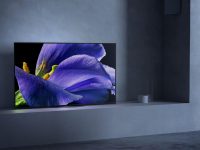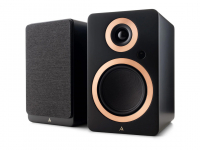
As one of a select few hi-fi companies that can trace their history back more than 40 years, Arcam have seen myriad technologies come and go over the decades. With a range of products that encapsulates all of their beliefs regarding design and engineering, Arcam are as well-placed now as they’ve ever been to create fantastic audio equipment, taking advantage of new innovations whilst building upon the traditions and ideals that made them the audio powerhouse that they are today.
The Solo Music is a shining example of new technology meeting old. After all, it’s not often you’ll see a one-box system released these days with playback of both SACD and Bluetooth featured. Nor is it particularly common to find a hi-fi system that incorporates HDMI inputs alongside the more traditional RCA and 3.5mm sockets. Arcam obviously see a perfect union between these technologies, and whilst it may seem something of a mish-mash on paper at least, the pedigree of the brand definitely justifies a closer look at what’s on offer.
Having already given the game away as to some of the features of the Solo Music, let’s have a quick look at how the industrial design side of things stacks up. It’s probably fair to call the Solo Music an unusual looking bit of kit, which is not to say it’s unattractive. In fact, with its top-mounted controls and fairly minimalist fascia, it’s pretty stylish, albeit in a sort of understated, plain-jane sort of way. Beauty, as they say, is in the eye of the beholder, and we were fairly split in-store as to exactly who liked the design and who wasn’t so keen, but fair play to Arcam; even without the remote or matching app, the Solo Music was easy to navigate because of this straightforward, simple layout.

Of course, it’s the performance of the Solo Music that’s really the reason for anyone to consider purchasing it, and this is where Arcam’s engineers have busted out their strongest work. Using their favoured Class-G amplifiers, the Solo Music can kick out 80 watts per channel into an 8-ohm load, pushing up to 125w into each stereo channel at 4 ohms. Class-G amplification, for those unfamiliar, utilises multiple power supplies, with additional power kicked out from the extra supplies as and when a speaker demands it. This means the Arcam is very efficient in its power handling, keeping heat waste down and still delivering clean and clear power too.
As mentioned earlier, the Arcam sports four HDMI inputs (1.4b version) and one output, allowing devices such as Sky or Virgin, games consoles, or PVR’s to be connected directly in before being fed back out to a screen. This has been the standard way to process audio and video in home cinema for many years now, but it is unusual to see it on a device primarily marketed for hi-fi purposes. It’s definitely a big plus point, though, with the Solo Music much slimmer than most AV amps, and ideal for those only wanting to go 2-channel.
More traditional connections are also fitted, with one set of RCA sockets, one optical and one coaxial connection all making an appearance. USB is here for anyone looking to hardwire a PC or a laptop. The Solo Music also has Bluetooth streaming, and with Wi-Fi built in, home network streaming is here, too. SACD playback obviously also means that standard CD is catered for also. Last but not least, DAB / DAB+ and FM also make it onto the spec sheet, giving plenty of options by anyone’s standards.

Monitor Audio Silver 6’s
Given the power on tap here, the Arcam partnered up nicely with pretty much anything we threw at it. Most of our listening was with the Solo Music matched to the Monitor Audio Silver 6 speakers, but the Arcam’s balanced and even-handed approach made it an easy match-up with most brands. After a decent run in, the Arcam was ready for a proper going over.
Right from the off, the Solo Music impressed with plenty of punch and control. Listening to the Jamie xx album, In Colour, the Arcam handled opener Gosh with aplomb, delivering the heavy bass synth with real impact, but managing to keep a tight grip on things when the siren-like chords kick in as the track grows, pushing them to the forefront without allowing the bottom end to wander off. Second track and first single from the album, Sleep Sound, made sure that the Arcam had a good sense of rhythmic control, stopping any chance of overhanging bass from ruining the skittering percussion that rides through the track.
Arcam’s app made playing music from the store’s network a doddle, with no headaches involved in getting things up and running. Playing back Philip Glass’ Naqoyqatsi soundtrack, featuring the superb Yo-Yo Ma on cello, gave the Solo Music a chance to show how well it could handle scale and dynamics. Massman is one of the album’s standout tracks, its brooding opening highlighting Ma’s stunning playing, but also Glass’ orchestral abilities. By the time the track breaks into a full march at its finale, the Arcam had scaled from the very depths to the highest peaks; letting the orchestra breathe, never making things sound shut in or crowded. For a product that probably falls into the category of “mini system”, it was certainly sounding like a full-on “hi-fi” system.
That’s pretty much Arcam to the letter, though. Whilst they’ve made sure that all and sundry are accommodated through its wealth of connections, that the box count is kept low and that things look neat and tidy, it’s obvious that first and foremost, the Solo Music was designed to sound fantastic; to be all about the music. Its ability to get to the heart of recordings, to present details honestly and without embellishment, and yet still have FUN doing so, make it one of the best products we’ve listened to all year. Heartily recommended!
Shop for Arcam with Richer Sounds.
Author: Chris, Liverpool store





